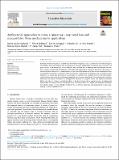Por favor, use este identificador para citar o enlazar a este item:
http://hdl.handle.net/10261/254339COMPARTIR / EXPORTAR:
 SHARE
BASE SHARE
BASE
|
|
| Visualizar otros formatos: MARC | Dublin Core | RDF | ORE | MODS | METS | DIDL | DATACITE | |

| Título: | Antibacterial approaches in tissue engineering using metal ions and nanoparticles: From mechanisms to applications |
Otros títulos: | Metal ions; Metal nanoparticles; Mechanism of action; Antibacterial activity; Tissue engineering; Biomaterials applications | Autor: | Godoy-Gallardo, María; Eckhard, Ulrich CSIC ORCID ; Delgado, Luis M.; Roo Puente, Yolanda J.D. de; Hoyos-Nogués, Mireia; Gil, Francisco Javier; Pérez, Román A. | Fecha de publicación: | dic-2021 | Editor: | Elsevier | Citación: | Bioactive Materials 6(12): 4470-4490 (2021) | Resumen: | Bacterial infection of implanted scaffolds may have fatal consequences and, in combination with the emergence of multidrug bacterial resistance, the development of advanced antibacterial biomaterials and constructs is of great interest. Since decades ago, metals and their ions had been used to minimize bacterial infection risk and, more recently, metal-based nanomaterials, with improved antimicrobial properties, have been advocated as a novel and tunable alternative. A comprehensive review is provided on how metal ions and ion nanoparticles have the potential to decrease or eliminate unwanted bacteria. Antibacterial mechanisms such as oxidative stress induction, ion release and disruption of biomolecules are currently well accepted. However, the exact antimicrobial mechanisms of the discussed metal compounds remain poorly understood. The combination of different metal ions and surface decorations of nanoparticles will lead to synergistic effects and improved microbial killing, and allow to mitigate potential side effects to the host. Starting with a general overview of antibacterial mechanisms, we subsequently focus on specific metal ions such as silver, zinc, copper, iron and gold, and outline their distinct modes of action. Finally, we discuss the use of these metal ions and nanoparticles in tissue engineering to prevent implant failure. | Descripción: | © 2021 The Authors. | Versión del editor: | http://dx.doi.org/10.1016/j.bioactmat.2021.04.033 | URI: | http://hdl.handle.net/10261/254339 | DOI: | 10.1016/j.bioactmat.2021.04.033 | ISSN: | 2452-199X |
| Aparece en las colecciones: | (IBMB) Artículos |
Ficheros en este ítem:
| Fichero | Descripción | Tamaño | Formato | |
|---|---|---|---|---|
| Antibacterial_Godoy_PV_Art2021.pdf | 7,3 MB | Adobe PDF |  Visualizar/Abrir |
CORE Recommender
PubMed Central
Citations
92
checked on 07-may-2024
SCOPUSTM
Citations
181
checked on 24-may-2023
WEB OF SCIENCETM
Citations
153
checked on 07-may-2023
Page view(s)
68
checked on 06-may-2024
Download(s)
366
checked on 06-may-2024

